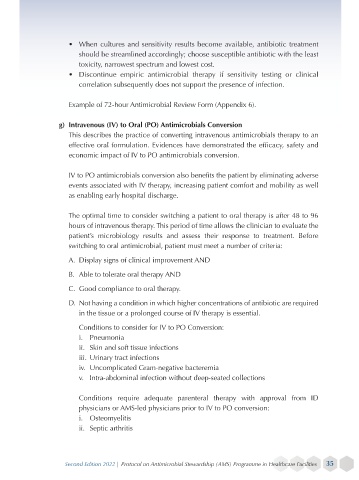Page 37 - C:\Users\ToRiM\Desktop\New folder2\
P. 37
• When cultures and sensitivity results become available, antibiotic treatment
should be streamlined accordingly; choose susceptible antibiotic with the least
toxicity, narrowest spectrum and lowest cost.
• Discontinue empiric antimicrobial therapy if sensitivity testing or clinical
correlation subsequently does not support the presence of infection.
Example of 72-hour Antimicrobial Review Form (Appendix 6).
g) Intravenous (IV) to Oral (PO) Antimicrobials Conversion
This describes the practice of converting intravenous antimicrobials therapy to an
effective oral formulation. Evidences have demonstrated the efficacy, safety and
economic impact of IV to PO antimicrobials conversion.
IV to PO antimicrobials conversion also benefits the patient by eliminating adverse
events associated with IV therapy, increasing patient comfort and mobility as well
as enabling early hospital discharge.
The optimal time to consider switching a patient to oral therapy is after 48 to 96
hours of intravenous therapy. This period of time allows the clinician to evaluate the
patient’s microbiology results and assess their response to treatment. Before
switching to oral antimicrobial, patient must meet a number of criteria:
A. Display signs of clinical improvement AND
B. Able to tolerate oral therapy AND
C. Good compliance to oral therapy.
D. Not having a condition in which higher concentrations of antibiotic are required
in the tissue or a prolonged course of IV therapy is essential.
Conditions to consider for IV to PO Conversion:
i. Pneumonia
ii. Skin and soft tissue infections
iii. Urinary tract infections
iv. Uncomplicated Gram-negative bacteremia
v. Intra-abdominal infection without deep-seated collections
Conditions require adequate parenteral therapy with approval from ID
physicians or AMS-led physicians prior to IV to PO conversion:
i. Osteomyelitis
ii. Septic arthritis
Second Edition 2022 | Protocol on Antimicrobial Stewardship (AMS) Programme in Healthcare Facilities 35

